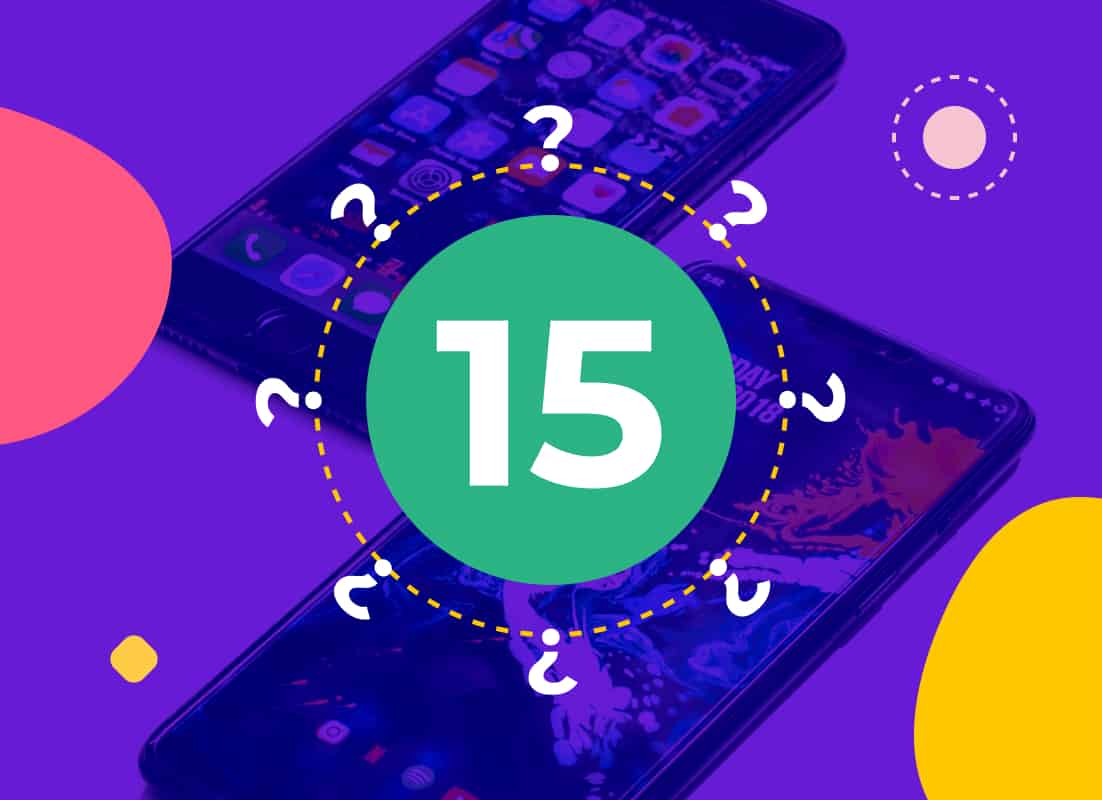
16 min read
15 Mobile App Developer Interview Questions to Assess Competence
Mobile app development is a fast-paced and lucrative industry. The mobile market is estimated to be worth $212.72 billion in 2022. It’s expected to grow at a compound annual growth rate of 13.4% between 2022 and 2028. It’s a thriving niche.
The right mobile app developer can help your business succeed, so it’s important to know what you’re looking for. We’ve prepared 15 interview questions and answers you can ask during interviews. Below you will find 10 mobile app design interview questions as well as 5 soft skill questions.
Mobile App Interview Questions and Answers: Hard Skills
It’s crucial to hire a mobile app developer who is passionate about what they are doing, possesses the required technical expertise, and never stops learning.
1. What Are the First Three Things You Do When You Start Developing an App?
Here, your goal is to determine whether a developer has a pipeline they’re used to working within, what its pre-development stage is like, and why it’s constructed in that specific way.
The answer might be:
I first study the project’s requirements, existing documentation that covers the project, code that’s already written, and existing apps/their versions if there are any. That helps to get a context of what has been done and what’s the first thing I’ll be doing on the development team. It also lets me check out the team’s code conventions from the beginning.
2. What Are the Benefits and Drawbacks of Your Approach to Mobile Development?
This question showcases if a developer understands how to align product goals of app development with the decisions about the method of development.
Answer from a developer that works with cross-platform technology:
I work with React Native, so that means I get to bring two versions of the app from JavaScript, which I’ve known far longer than I’ve been into mobile development. I love that they’ve introduced new debugging tools (Flipper) and fast refresh (as a replacement for the buggy hot reload feature). There are downsides to RN, of course. Although major companies (see: Meta, who develops RN, Bloomberg, etc.) use it as the main tool to build their mobile apps, it’s a struggle, for instance, to write original and complex native components. I often have to edit three code bases: for the Android operating system, iOS, and JavaScript to edit just one of them.
Answer from a developer that works with Java or Kotlin or Swift/Objective-C:
I work with Kotlin and develop native mobile apps for Android. Kotlin is fast, highly performative, compatible with the Java programming language, concise, and expressive. However, Kotlin has issues with runtime speed, it doesn’t have static modifiers, and documentation is still often sparse.
3. How Do You Ensure the Security of End Users?
Many cyber threats can affect user data and cause irreversible consequences for your business.
The answer might be:
To secure the users of a mobile app, I would set up two-factor authentication, forbid the app from showing sensitive data in push notifications (like ID card number, and details of health/financial info), blur the app’s screen when the user is switching between apps (like many bank apps do), and limit user’s session duration.
4. How Would You integrate Animation Into the App’s UI?
Let’s see how app developers deal with animations.
The answer might be:
From a cross-platform developer:
In Flutter, there are several ways you can animate things. I can call CustomPainter/animation frameworks like Rive or import animation from Figma files. Or I can add code-based animation: via FadeTransition (or other explicit animation widgets), AnimationController with an added listener, and setState; or through using animated versions of classic Flutter widgets. To optimize the app’s performance, I often use AnimationBuilder to save widgets in the cache and re-use them in animation. I also use tweaks that restrain Flutter from redrawing animation as soon as a new effect/property is introduced, e.g. I use AnimatedOpacity instead of the Opacity widget. I test animations on all relevant devices and operating systems.
From a native developer:
I develop native mobile apps for Android, and animations — especially micro-animations for UI — are what make the app feel like an Android app. I use MotionLayout to handle complex transitions in UI, use classes like SpringForce and Spring library for smooth physics-based animation (really good-looking on splash screens, onboarding guides to the apps, etc.), and follow less than 60 FTP & Material Design guidelines for animations to make sure the motion inside the app looks good.

5. How Can You Save Disk Space When Building an App?
Lack of storage is one of the main reasons people delete apps. App size also has a direct impact on the apps’ conversion rates.
The answer might be:
For a native iOS developer: To reduce the app’s size, I use ProGuard as a code shrinker and a garbage collector to clean up memory space (and make sure the collection keeps running in the background while the app is working). I also try to limit the use of external libraries, compress images, and upload apps to Google Play store/Play Market via Android Bundle.
For a cross-platform developer: React Native supports armeabi and x86 architecture and automatically builds libraries for both of them into an APK file. I separate Android builds to create split versions of them for .apk, which reduces the app’s size. For iOS, I do app thinning, host on-demand assets/resources in the App Store, and keep data for runtime on the server.
6. What Are the Biggest Challenges You Have Faced During Mobile App Development?
The most experienced developers should see the big picture and understand both technical challenges as well as product challenges.
The answer might be:
For native Android developers, the most challenging thing is often the fragmentation of the Android system and screen resolutions: ideally, the app must look good on popular versions of Android/common screen sizes. It’s all about the relentless testing of Android mobile applications via emulators/devices.
For native iOS developers, the main challenge is to pass the App Store review. For instance, with in-app purchases: if an app leads to a third-party resource for a purchase, it’s a violation of Apple policies. The security of user data is another challenge. The app shouldn’t advertise in push notifications, widgets, and so on. You should always stay on top of App Store Review Guidelines.
For cross-platform developers, the challenges vary. For example, injecting native components into the code, app’s performance, optimizing for various screen resolutions, and more.
7. Name Your Favorite Dev Tools/Frameworks. What Are Their Drawbacks and How Do You Overcome Them?
There’s a number of tools for various purposes used in app development.
The answer might be:
For native app developers: I do Android development, so I make use of Android SDK. I used to work with Eclipse as an IDE before the Android Studio release, and was sad to part with it — it was pretty comfortable. I pick LeakCanary to find and fix memory leaks, use Gradle to add Java packages/libraries into Studio projects, and utilize Android Asset Packaging Tool (or AAPT2). I also try to master Unity’s graphical user interface and its “outs” for Android phones — with its recently introduced capabilities for building an industrial Android application with XR, it seems like a worthy time investment. For mobile app testing, I use tools within Android Studio, too, and have taken up AVD Manager as an emulator for performance/responsiveness tests.
For cross-platform developers: I love Flutter: setting it up is easy, adding third-party packages is extremely quick, and Dart is straightforward and fun to write in once you get into it. Also: Skia’s rendering means it’s easy to create apps at 60FPS, it compiles code quickly and natively — and this means that building the app’s UI close to mockups/clickable prototypes is super easy. Flutter’s errors sometimes are tough to resolve/find the roots of, although there are tools to simplify the process.
8. Do You Prefer Working With Monolithic or Modular App Architecture?
Every developer should know the underlying architectural principles and their pros and cons.
The answer might be:
Those who’ll pick monolith architecture may say that they’re simpler to develop and release, very easy to test, and quicker to build. Plus, the security is centralized and handled in one place. The cons of monolithic architecture would be less flexibility, the growing complexity of the architecture due to lots of new features & tangled-up dependencies, and, well, centralized security (because if that fails, everything else fails, too). Monolith mobile apps are often released as MVPs/test versions of the app because they’re so easy to develop.
Those who’ll pick modular app architecture will, most likely, be talking about microservices. Questions of architecture more often fall under the responsibility of backend developers, but if one would introduce composite UI to the app, various UI blocks would be generated and connected to corresponding microservices. Each UI component, then, would “check in” with a microservice on the backend that’s responsible for reacting to events that happen within that UI component. That would allow developers to apply the benefits of modular app architecture to the app’s UI: quick & easy editing, flexibility, better performance, and so on. Microservices within the UI would benefit large mobile apps with lots of user input and would be basically useless in small MVPs.
9. Describe Apple and Google’s App Protection & Sandboxing Methods
Your app developers should have at least a basic understanding of how apps are protected in iOS and Android.
The answer might be:
Native mobile applications on iOS and Android are automatically “sandboxed” — forbidden from interacting with anything that’s outside the app (unless there’s user permission to, e.g. use the camera, microphone, GPS, etc.). Google Android SDK isolates the app by using the system-assigned app’s UID to create a kernel-level App Sandbox (where kernel is a core program in Android that manages the phone’s resources, CPU, memory, etc.). Kernel enforces security, preventing the app from reaching outside (but there are other safeguards in different operating systems under the Android umbrella that “complement” the initial sandbox).
Apple uses a similar sandboxing system, and it’s strengthened by Address Space Layout Randomization (ASLR), a mechanism built into iPhone/iPad apps that randomly “shuffles” important programs, system libraries on the device, and so on. If users run a program that tries to execute a malicious code, it’s harder for the code to reach the places in the system it’s designed to exploit.
10. Describe the Pros and Cons of Emulators for Develop Mobile Apps
This question will, again, show mobile app developers’ understanding of how circumstances impact the decision on what tools to use — this time, for mobile application testing.
The answer should be:
| Pros | Cons |
| They speed up the testing process — it’s easier to use Chrome’s DevTools than to find an iPhone/Samsung with each version of an iOS/Android device and screen resolution. | They can’t give an accurate picture of the app’s performance and memory management capabilities. |
| They allow for an approximation of how to fix user interface issues/layout. | It’s impossible to thoroughly test hardware features (like cameras). |
| They are good for early-stage development | They do not allow the developer to perfectly tune UI within iOS and Android systems. |

Mobile App Development Interview Questions and Answers: Soft Skills
A mobile app developer should have the soft skills to work with different kinds of people remotely and be able to communicate effectively. Below are mobile app interview questions you should ask every developer. In most cases, their non-verbal reactions tell you more than the actual answers.
11. Can You Work Solo? What Do You Like/Don’t Like About It?
In a remote world, you want your mobile app developers to be self-sufficient.
The answer might be:
I’m comfortable with working alone because I like to solve problems myself. However, I also enjoy collaborating with others because it helps me learn new things from them and make improvements to my codebase.
12. Your Colleague Made a Mistake That Delayed the Project. How Will You Inform Them About It?
This question will help you understand if a candidate can provide negative feedback helpfully & constructively, without getting into a conflict.
The answer might be:
It would largely depend on the subordination, but generally, I would approach them and tell them about their mistake, and the impact it had on the project, and ask them a) why they think the mistake happened, b) how they can avoid mistakes like this in the future, c) how I (if I’m a manager) or the team can aid them in avoiding this mistake, d) how, in their opinion, it’s best to fix it.
13. What Do You Like the Most About Being a Mobile App Developer? What Do You Like the Least?
This question is a chance for an interviewee to show enthusiasm and passion for the job.
The answer might be:
What I like the most about being a mobile app developer is that I can be more creative and express myself through my work. I can make things and solve problems that I see in the world.
14. Have You Ever Worked Remotely? Name a Few Pros and Cons of Working in a Remote Team and the Office
Working remotely can be a great way to manage your schedule and avoid the daily grind of commuting, but it comes with challenges.
The answer might be:
Working at home, people often get distracted with cooking, cleaning, and doing other chores. They miss out on bonding with coworkers and the banter of an office. On the other hand, working remotely gives you more freedom over your schedule and place of work. You don’t have to commute every day, which saves time and money — and gives you more opportunities to exercise or spend time with friends and family. It’s pretty comfortable.
To organize my working process, I divide my apartment into work zones and home zones. I make sure all the work that requires a lot of focus is divided into chunks and scheduled for the morning hours when I don’t have meetings.
15. What Questions Do You Have About the Project?
You want your mobile app developer to be interested in what you’re trying to build and the problems you’re trying to solve.
The answer might be:
- What tools do you use? Jira? Figma? What else?
- How often will we have meetings?
- What does the current team look like?
- What technologies do you plan to use or already using?
- Tell me more about the market, users, problems, and use cases of the app.
Asking the Right Mobile App Interview Questions to Hire the Best Developers
We hope these mobile app developer interview questions will help you better assess your candidates. Use these mobile app development interview questions as a foundation but remember that interviews are often circumstantial. It’s often better to ask contextual tech- and soft skills-related things that are relevant to a specific candidate.
If you don’t want to go through hundreds of CVs and interview dozens of candidates, you can hire the top 1% of mobile application developers through Expert Remote. All developers in our network have passed our rigorous interview process.
Remote tech teams & the future of work blog
Remote tech teams & the future of work blog
Your form has been successfully submitted.


